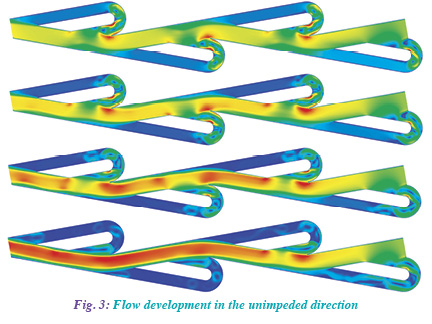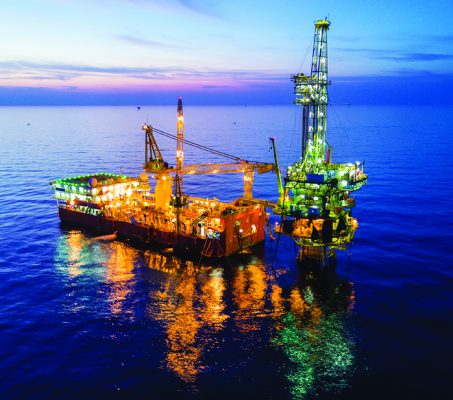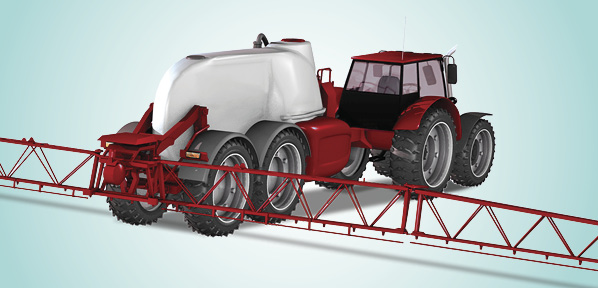Tesla’s Valvular Conduit
Nikola Tesla is well known for his contributions to electrical engineering, so it’s more than a little surprising to hear that he also made contributions to fluid power. Thanks to the popularity of the Internet, many of these old and forgotten investments are coming to light, including a device called a “Tesla Valve.”
A Tesla Valve is like a typical valve, but with one key difference: absolutely no moving parts. It has a design that allows fluid to flow unimpeded in one direction, but in the other direction, the fluid is blocked. Tesla gives the following explanation in his patent (Fig. 1): “The interior of the conduit is provided with enlargements, recesses, projections, baffles, or buckets which, while offering virtually no resistance to the passage of the fluid in one direction, other than surface friction, constitute an almost impassable barrier to its flow in the opposite [direction].”
The fact that something is patented is not proof that it actually works. The idea of a valve without moving parts sounds intriguing. Such a device would need little maintenance and would be able to withstand harsh conditions like heat, humidity, and repeated use. For this reason, I decided to set out to discover whether such a device was really possible.
Computational Fluid Dynamics (CFD) seemed like the perfect way to not only measure the device’s effectiveness but also to “look inside” the device to see how it actually worked. There are no dimensional drawings of the device, so I had to painstakingly trace it from the illustrations in his patent (with the help of a ruler and protractor). After I created the model, I simulated flow in each direction—the blocking direction and the unimpeded direction.
Fig. 2 shows the fluid traveling in the blocking direction (flowing left to right). The top frame is what the flow looks like initially, progressing toward the fully developed flow in the fourth frame. The red represents the areas where the fluid is moving the fastest. In the blocking direction, the flow follows a serpentine path around the outside channels of the device, just as Tesla intended. Because of this, the bulk of the fluid is forced to follow a long, narrow, and turbulent path. The effect is a huge pressure drop, making it very difficult to push the fluid in this direction.
Fig. 3 shows the development of the fluid in the unimpeded direction (from right to left). After a few seconds, the flow develops a nice slipstream down the middle of the conduit. The blue represents areas with little to no movement. The bulk of the fluid is able to follow a wide and mostly laminar route, and thus the only losses are due to surface friction.
Tesla quantified the effectiveness of the device by calculating the ratio of resistance in one direction compared to the other. He made the bold claim that “The resistance in the reverse may be 200 times that in the normal direction […] so that the device acts as a slightly leaking valve.”
How does this CFD model of the device measure up? The first simulations were actually half the length of the ones pictured (only two segments). In this case, the resistance in the blocking direction was 15 times greater than the unimpeded direction (4.79 kPa vs. 0.318 kPa). For the four-segment version pictured, the ratio was a whopping 40.8 (23.7 kPa vs. 0.581 kPa). The illustration in Tesla’s patent included a total of 11 segments. While I did not model the full version, it seems plausible that a pressure ratio of 200 could be achieved.
If the device really worked, why are we not using it to this day? Tesla designed the valve as part of his new steam engine with the hope of increasing power plant efficiency. However, less than a month after Tesla filed the patent, he had to file for bankruptcy. This marked the end of many of the ambitious projects he had been working on. By the time the patent expired 20 years later, the device was already forgotten.
Countless patents have suffered similar fates, never having the chance to reach their potential. While there are many patents that do not work as advertised, there are just as many perfectly valid and useful patents. It takes work and skill to separate the good from the bad, but there is much to gain from doing so.
New patents are expensive and temporary. Old patents are free and guaranteed to be free forever. While we need new ideas, there’s also a world of existing innovation that’s just waiting to be built upon. There’s nothing wrong with taking an old idea and turning it into something fresh and useful. For every problem, there are many potential solutions, and the best solution may involve something that already exists.
About the Author: Nathan West is a recent graduate of Mechanical Engineering from Brigham Young University– Idaho and a Certified Fluid Power Specialist. He can be reached via his online profile (www.linkedin.com/in/nathanwest42) or by e-mail: nathanhwest@outlook.com.











I have created a video of a Tesla valvular conduit machined from aluminium. It can be found here…. ://youtu.be/XhJtSqLz88Q
It’s mesmerising to watch this working. I’ve noted a 20% difference in pressure drop from one side to another at the small continuous flow rates I’ve developed. I’d love to hear from anyone else interested in seeing this or who has tested one, or who would like to obtain cad data to produce their own through rapid prototyping.
As this device needs a mass flow to block one conduit after each other, it will alwyas have/need a leakage, but so do other mechanical valves, but without the risk of malfunction, such as a stuck valve.. Impressive, very well thought out with none of the now so popular CFD even beeing dreamed of.
Mechanical valves can be made with pretty much zero leakage (not counting the brief leakage that occurs when flow reverses, before the valve closes).
Tesla an amazing man and mind. Even today his ideas and inventions are still and for the foreseeable future valid.
TRY DAVID ADAIR
https://www.youtube.com/watch?v=6xL6ZB27MK0
Tesla also created the Tesla turbine (also called bladeless turbine). Did not know about this valve, but seems that whenever he needed something to solve a problem, he quickly came with a superb answer in any field of knowledge.
Interesting, how it seems both his flow inventions lack in efficiency but make it up in robustness. The turbine is less efficient than modern turbines but since machining rotary-symmetrical parts like the discs (with few exceptions; regular holes in the middle), it allows for high speeds with far less complex manufacturing process. This valve… leaks. 🙂 And not even a little. Still, it can resist a huge pressure, and it has no moving parts that could suffer wear.
The tesla valve allows a steam boiler to become a closed system. It not so much a valve as it is a diode for force.
i would like buy tesla valvular conduit how i must to do for buy it ?
Hello there
Did you manage to buy one of these? If not i can help. I love Teslas inventiveness and am trying to collate them on my site. http://www.physicshack.com
Regards
David
I SHALL BUY ONE
It could be make of concrete on fast moving mountine rivers to prevent from flooding the area
There are easier ways to slow down a river… unless you need it flow both ways, but fast only in one direction 🙂
is data available as to psi and gpm for a given orfice size in this valve? also would leakage in reverse flow mode be available?
So I’m curious how this would work if a solid was passed through the free flow side at the same time it is resisting a fluid from the other. Would it cause a reverse in the direction of the fluid with the pressure being drawn back against itself as the solid passes the chambers? As a test I would have to submerge almost the entire valve in water and drop ball bearings through the free flow side and then measure the flow rates inside the chambers as above. A test like this could prove to be a value in free energy since you can pass a solid below water levels inside the valve using gravity and allow it to use buoyancy on the upswing once it passes the valve at a lower section of fluid…. currently not a possibility because you have to fight the pressure of fluids to get the solid to the upswing.
James would you email me at imvexus at gmail. I’d like to hear more about what you are talking about.
Suppose a big long Tesla valve was made into a big closed loop with no entry or exit. Would the molecules of air tend to want to move in one direction more than another and if so would the air in the loop start flowing in one direction with enough force that it could be harnessed as a source of energy? It seems like this should violate some basic law of thermodynamics.
REMEMBER THAT A GAS OR A LIQUID HAS A NATURAL VIBRATORY MOTION. EVENTUALLY THE SMALL VIBRATORY MOTION WOULD CAUSE A GRAND SCALE MOTION.
Yes, it would not work because there would be nothing causing it to move in the other direction, just something stopping from moving it in one direction. Stopping something from moving one way does not make it move in another way.
The closed Tesla valve loop idea is similar to another situation. If a tube was connected in a closed loop and sealed inside if a container, could the air inside the loop be made to self circulate in one direction by poking holes angled in one direction. If the holes were very narrow and the air oressure were very low it seems that the holes would tend to let air going in one in and air going in the other direction out so that there would be a current flow in one direction eventually. This also seems like it should violate a law of thermodynamics.
.
This seems very useful for situations in which brief moments of high pressure develop, and leakage doesn’t matter. For instance, pumping. A pair of valves like this coupled to a piston could comprise an adequate pump for many applications.
So for a water pump consider making it rotary, a spiral or screw the outside of a cylinder can work … a new thought to me.
It can be self-priming with enough “threads” for doing the air at first at higher rpm, once water enters it’d chug-a-lug.
Luv this, and honestly have used it before, counter-flow from the main flow, a dynamic disruption ending net zero on energy transfer, using that in tsunami runup hillside barriers & seawall concepts.
If you slowly pump a high viscosity cream you will find no difference between the two direction. Under laminar flow conditions there is no reason for a difference because the surface resistance is identical. The fact that your simulation shows turbulent regions proves that the flow is not laminar. Without turbulence there is no “Tesla effect”.
The point of the Tesla Valve is to cause the turbulence. You’re going to get turbulent flow in the reverse direction at speeds that normally have only laminar flow.
This is the design fix for the Oroville Dam Spillway! Potential energy of the water will be converted to heat as it slows the mass. Discharge 700+ Ft below will lack velocity so as to control momentum and inertia.
Steve M. Hathaway
Just what I needed for steam generator unit on my Windsolars, and same principle can be used wherever uni directional flow / movement have to be used. I was beating my head how to avoid moveable parts as they can fail but Tesla has solved this problem long ago.
Regards from Croatia, the Homeland of Engineer Nikola Tesla!
This is what allowed Tesla to throw water in to his exhaust gas without causing a steam explosion so you’re right on with that. 😉
Source: Am building Tesla turbo-engine and am invested in a lack of steam explosions. <.<
At the mouth of a river, to block storm surge from reaching a city upstream.
Thank you so mash dear brother
I am thinking that Tesla valve will be helpful in the area where flood is frequent.This Tesla valve will work very efficiently in reducing strong water flow and will bring the water less or more stable.